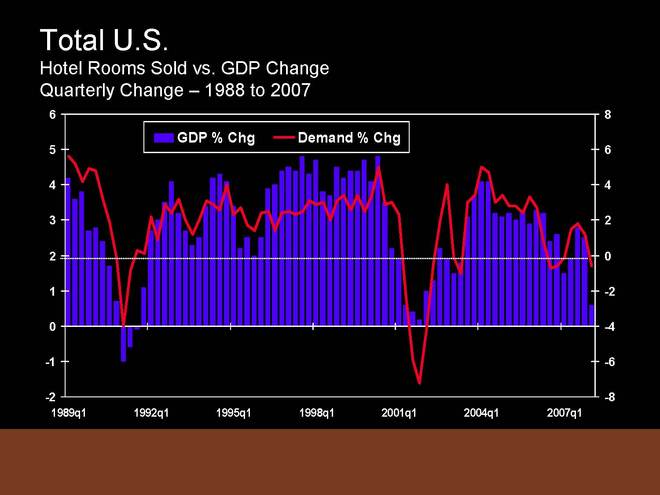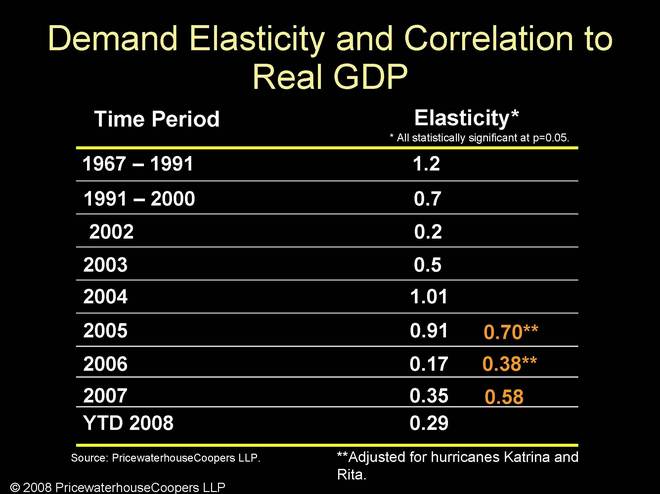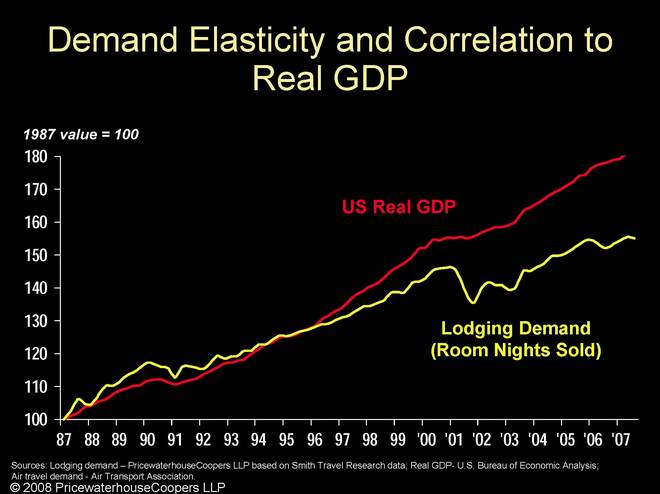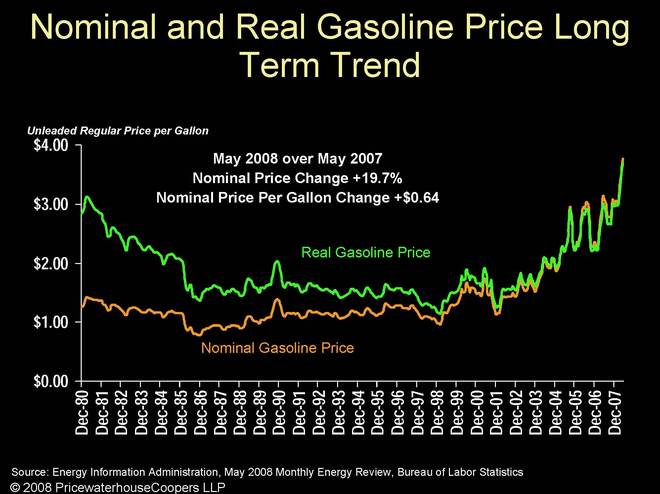Author of www.HotelLawBlog.com
11 June 2008
Hospitality lawyer with pearls from the New York hospitality conference. The mood in New York was more somber in June 2008 than it has been for a long time at hotel conferences. Final attendance was about 2400 (about the same as last year) and for the first time, NYU had fewer conference delegates than the Los Angeles conference in January (3,200 at ALIS in January 2008). Many believe that attendance at these conferences is a good barometer of sentiment in the industry — send more people when times are good, and send fewer when you batten down the hatches for a storm.
I had the opportunity to listen to Randy Smith and Mark Lomanno of Smith Travel Research in two sessions this past week — one private session at the Lodging Industry’s think tank (the Lodging Industry Investment Council or LIIC) and in the general opening session at NYU. I also had the good fortune to hear the fascinating presentation made by Bjorn Hanson, principal of PricewaterhouseCoopers LLP (retiring effective June 30, 2008), which informed much of what I had heard from my friends at STR. My commentary includes selected slides from STR and PwC. A link to the full STR presentation can be found at the end of the article. Here is a Hospitality Attorney’s executive summary.
PEARLS OF WISDOM
There were just too many pearls of wisdom gathered in New York for one blog. So to make them more digestible, we have broken them into segments as follows:
State of the U.S. Lodging Industry
What’s Weekday vs. Weekend demand tell us?
Whither Lodging Demand, GDP and the Cost of Gasoline?
Top Quips, Quotes and Insights from the 2008 NYU hotel conference
All these segments will be posted shortly, so check back if you don’t see the one you want.
It was only a few months ago that hotel industry pundits speculated that we were only in the 3rd or 4th inning of the good times for the hotel industry’s surge in growth and profits. Now, at least a few revel in predicting looming bankruptcies, receiverships and workouts.
Hotel Lawyer summary of the Smith Travel Research data presented at NYU Hotel Conference
• The real rate and RevPAR growth excitement today is “international”
• The hospitality industry is going to be “fine” in the near term, slowing down to overall RevPAR growth of 3% for 2008 and 2.8% for 2009, and going up from there (the 2008 and 2009 numbers are not far under the 20-year average of 3.4% growth)• The results will be better than these averages for the “Growth Scales” (luxury, upper upscale, upscale and midscale without F&B), and worse for the “Mature Scales” (midscale with F&B and economy)
• There is still a very high correlation between changes in U.S. GDP and demand for hotel rooms (as measured by room nights sold)
• New supply is diminishing, and there is less cause for concern today about new supply than there was a year ago. This bodes well for profits as a recovery picks up in late 2009 or 2010
• The damaging practice of “discounting” to maintain market share (and its downward spiral) has NOT emerged. There is no indication that discounting is a successful strategy to maintain or improve profits
• Airline capacity and lift will have an impact on the industry, but Lomanno notes that airline prices were much higher in the 1970s and 1980s and Smith says that if airline prices go up, people will still drive or take the train
Please note that I have inserted selected slides from the STR presentation below, and the full STR slideshow is available with the link at the very end of this article.
CORRELATION OF GDP AND HOTEL ROOM DEMAND
One of the things that has fascinated me about the hospitality industry for more than 20 years now, is the close — almost intimate — relationship of industry performance to the U.S. economy’s performance. Some might say this is intuitive, that when the economy does well, all business does well. But that is not always true. There are some businesses which do better in hard times, like discount and bargain stores, and there are some that seem impervious, like ultra luxury goods. However the relationship of the lodging industry’s performance to the general economy has been carefully documented by the experts, and it is worth noting. The implications are interesting.
I find this chart from STR to be a graphic re-affirmation of the intriguing relationship between the U.S. GDP and hotel room demand.
Bjorn Hanson, principal of PricewaterhouseCoopers LLP (retiring effective June 30, 2008), also gave us an update of his version of this data, and Bjorn was kind enough to share his graphics with me.
Demand Elasticity and Correlation to Real GDP
Bjorn and economists speak of the “elasticity” of demand. In the case of the lodging industry and the U.S. economy, the relationship has historically had a very close statistical “correlation.” A correlation of “1” is a very high correlation establishing virtually a direct relationship between two items. As you can see from the following chart, the correlation between lodging demand and the U.S. Real GDP was 1.2 for 24 years from 1967 through 1991.
What does this mean? It means that if the U.S. economy grew by 1%, then lodging demand grew by 1.2%. This is pretty remarkable. But then, for about a decade between 1991 and 2000, the correlation dropped to .7. That meant that if the U.S. economy grew by 1%, then lodging demand grew by .7%. This is still a very impressive correlation, though not as strong as before.
Then, as you can see from the chart, everything changed in 2002 after 9-11 when the correlation plunged to .2 in 2002, rose to .5 in 2003, got to 1.01 in 2004, and has wobbled a bit the past few years, but still at a very high level of correlation or direct relationship. (Bjorn says that any correlation higher than .05 is statistically significant.)
Here is another of Bjorn Hanson’s charts that illustrates the relationship a different way.
In this chart, you can see how the U.S. Real GDP and lodging demand tracked so closely from 1987 until 2002, and then virtually reset at a lower scale, but still roughly paralleling the GDP.
This is an amazing correlation or relationship. Of course, the supply side of things is also critically important to the impact on profitability of the U.S. lodging industry. But these charts, and the correlations that PwC has documented, show how important the economy is to our industry. No matter how strong the industry fundamentals may be — and they are very strong right now — the lodging industry will be directly affected by any economic downturn, as the demand growth will almost certainly parallel the GDP.
What does the price of gasoline have to do with lodging demand?
It appears that the U.S. GDP is the best predictor of lodging demand for room nights in the United States. But Bjorn Hanson and his team at PwC have also noted a meaningful correlation of the price of gasoline and the demand for room nights.
Here is Bjorn’s slide on the real cost of gasoline.
And what is the relationship? PwC has calculated that when real gasoline prices increase by 10%, U.S. lodging demand declines by 0.5%. And to put this into a practical context, Bjorn says that if real gasoline prices had remained at the levels they held in the fourth quarter of 2006, then occupancy in 2007 would have been more than .2 occupancy points higher. And if the real price of gasoline remained at 2007 levels, occupancy in 2008 would be more than .4 occupancy points higher.
Very interesting stuff! Thanks again to PwC and STR for sharing this important information.
Link to STR’s full slide show at NYU Hotel Investment Conference 2008.
My take on the data is above. Here is the link to the full unadorned slide show as presented by Randy Smith of Smith Travel Research on June 2, 2008. STR 2008 Data.
This is Jim Butler, author of www.HotelLawBlog.com and hotel lawyer, signing off. We’ve done more than $87 billion of hotel transactions and more than 100 hotel mixed-used deals in the last 5 years alone. Who’s your hotel lawyer?
________________________
Our Perspective. We represent developers, owners and lenders. We have helped our clients as business and legal advisors on more than $125 billion of hotel transactions, involving more than 4,700 properties all over the world. For more information, please contact Jim Butler at jbutler@jmbm.com or 310.201.3526.
Jim Butler is one of the top hospitality attorneys in the world. GOOGLE “hotel lawyer” or “hotel mixed-use” or “condo hotel lawyer” and you will see why.
Jim devotes 100% of his practice to hospitality, representing hotel owners, developers and lenders. Jim leads JMBM’s Global Hospitality Group® — a team of 50 seasoned professionals with more than $87 billion of hotel transactional experience, involving more than 3,900 properties located around the globe. In the last 5 years alone, Jim and his team have assisted clients with more than 100 hotel mixed-use projects — frequently integrated with energizing lifestyle elements.
Jim and his team are more than “just” great hotel lawyers. They are also hospitality consultants and business advisors. They are deal makers. They can help find the right operator or capital provider. They know who to call and how to reach them.
Jim is frequently quoted as an expert on hotel issues by national and industry publications such as The New York Times, The Wall Street Journal, Los Angeles Times, Forbes, BusinessWeek, and Hotel Business. He is the Conference Chairman of The Hotel Developers Conference™ and Meet the Money®.
Contact him at jbutler@jmbm.com or 310.201.3526. For his views on current industry issues, visit www.HotelLawBlog.com.







